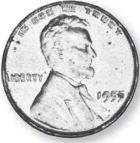
U.S. Minting Varieties
and Errors
Introduction
By Alan Herbert
The P.D.S. cataloging system used here to list minting varieties was originally compiled by Alan Herbert in 1971. PDS stands for the three main divisions of the minting process, “planchet,” “die” and “striking.” Two more divisions cover collectible modifications after the strike, as well as non-collectible alterations, counterfeits and damaged coins.
This listing includes 445 classes, each a distinct part of the minting process or from a specific non-mint change in the coin. Classes from like causes are grouped together. The PDS system applies to coins of the world, but is based on U.S. coinage with added classes for certain foreign minting practices.
Price ranges are based on a U.S. coin in MS-60 grade (uncirculated.) The ranges may be applied in general to foreign coins of similar size or value although collector values are not usually as high as for U.S. coins. Prices are only a guide as the ultimate price is determined by a willing buyer and seller.
To define minting varieties, “A coin which exhibits a variation of any kind from the normal, as a result of any portion of the minting process, whether at the planchet stage, as a result of a change or modification of the die, or during the striking process. It includes those classes considered to be intentional changes, as well as those caused by normal wear and tear on the dies or other minting equipment and classes deemed to be “errors.”
The three causes are represented as follows:
1. (I) = Intentional Changes
2. (W) = Wear and Tear
3. (E) = Errors
Note: A class may show more than one cause and could be listed as (IWE).
Rarity level
The rarity ratings are based on the following scale:
1 - Very Common. Ranges from every coin struck down to 1,000,000.
2 - Common. From 1,000,000 down to 100,000.
3 - Scarce. From 100,000 down to 10,000.
4 - Very Scarce. From 10,000 down to 1,000.
5 - Rare. From 1,000 down to 100.
6 - Very Rare. From 100 down to 10.
7 - Extremely Rare. From 10 down to 1.
Unknown: If there is no confirmed report of a piece fitting a particular class, it is listed as Unknown. Reports of finds by readers would be appreciated in order to update future presentations.
An Unknown does not mean that your piece automatically is very valuable. Even a Rarity 7 piece, extremely rare, even unique, may have a very low collector value because of a lack of demand or interest in that particular class.
Classes, definitions and price ranges are based on material previously offered in Alan Herbert’s book, The Official Price Guide to Minting Varieties and Errors and in Coin Prices Magazine.
Pricing information has also been provided by John A. Wexler and Ken Potter, with special pricing and technical advice from Del Romines.
Also recommended is the Cherrypicker’s Guide to Rare Die Varieties by Bill Fivaz and J.T. Stanton. Check your favorite coin shop, numismatic library or book seller for availability of the latest edition.
For help with your coin questions, to report significant new finds and for authentication of your minting varieties, include a loose first class stamp and write to Alan Herbert, 700 E. State St., Iola, WI 54990-0001. Don’t include any numismatic material until you have received specific mailing instructions from me.
Quick check index
If you have a coin and are not sure where to look for the possible variety:
If your coin shows doubling, first check V-B-I.
Then try II-A, II-B, II-C, II-I (4 & 5), III-J, III-L, or IV-C.
If part of the coin is missing, check III-B, III-C, or III-D.
If there is a raised line of coin metal, check II-D, II-G.
If there is a raised area of coin metal, check II-E, II-F, or III-F.
If the coin is out of round, and too thin, check III-G.
If coin appears to be the wrong metal, check III-A, III-E, III-F-3 and III-G.
If the die appears to have been damaged, check II-E, II-G. (Damage to the coin itself usually is not a minting variety.)
If the coin shows incomplete or missing design, check II-A, II-E, III-B-3, III-B-5 or III-D.
If only part of the planchet was struck, check III-M.
If something was struck into the coin, check III-J and III-K.
If something has happened to the edge of the coin, check II-D-6, II-E-10, III-I, III-M and III-O.
If your coin shows other than the normal design, check II-A or II-C.
If a layer of the coin metal is missing, or a clad layer is missing, check III-B and III-D.
If you have an unstruck blank, or planchet, check I-G.
If your coin may be a restrike, check IV-C.
If your coin has a counterstamp, countermark, additional engraving or apparent official modifications, check
IV-B and V-A-8.
Do not depend on the naked eye to examine your coins. Use a magnifying lens whenever possible, as circulation damage, wear and alterations frequently can be mistaken for legitimate minting varieties.
Division I: planchet varieties
The first division of the PDS System includes those minting varieties that occur in the manufacture of the planchet upon which the coins will ultimately be struck and includes classes resulting from faulty metallurgy, mechanical damage, faulty processing, or equipment or human malfunction prior to the actual coin striking.
Planchet alloy mix (I-A)
This section includes those classes pertaining to mixing and processing the various metals which will be used to make a coin alloy.
| I-A-1 Improper Alloy Mix (WE), Rarity Level: 3-4 | Values: $5 to $10 |
| I-A-2 Slag Inclusion Planchet (WE), Rarity Level: 5-6 | Values: $25 up |
Damaged and defective planchets (I-B)
To be a class in this section the blank, or planchet, must for some reason not meet the normal standards or must have been damaged in processing. The classes cover the areas of defects in the melting, rolling, punching and processing of the planchets up to the point where they are sent to the coin presses to be struck.
| I-B-1 Defective Planchet (WE), Rarity Level: 6 | Values: $25 up |
| I-B-2 Mechanically Damaged Planchet (WE), Rarity Level: – | Values: No Value |
| (See values for the coin struck on a mechanically damaged planchet.) | |
| I-B-3 Rolled Thin Planchet (WE), Rarity Level: 6 –(Less rare on half cents of 1795, 1797 and restrikes of 1831-52.) | Values: $10 up |
| I-B-4 Rolled Thick Planchet (WE), Rarity Level: 7 – (Less rare in Colonial copper coins. Notable examples occur on the restrike half cents of 1840-52.) | Values: $125 up |
| I-B-5 Tapered Planchet (WE), Rarity Level: 7 | Values: $25 up |
| I-B-6 Partially Unplated Planchet (WE), Rarity Level: 6 | Values: $15 up |
| I-B-7 Unplated Planchet (WE), Rarity Level: 6-7 | Values: $50 up |
| I-B-8 Bubbled Plating Planchet (WE), Rarity Level: 1 | Values: No Value |
| I-B-9 Included Gas Bubble Planchet (WE), Rarity Level: 6-7 | Values: $50 up |
| I-B-10 Partially Unclad Planchet (WE), Rarity Level: 6 | Values: $20 up |
| I-B-11 Unclad Planchet (WE), Rarity Level: 6-7 | Values: $50 up |
| I-B-12 Undersize Planchet (WE), Rarity Level: 7 | Values: $250 up |
| I-B-13 Oversize Planchet (WE), Rarity Level: 7 | Values: $250 up |
| I-B-14 Improperly Prepared Proof Planchet (WE), Rarity Level: 7 | Values: $100 up |
| I-B-15 Improperly Annealed Planchet (WE), Rarity Level: - | Values: No Value |
| I-B-16 Faulty Upset Edge Planchet (WE), Rarity Level: 5-6 | Values: $10 up |
| I-B-17 Rolled-In Metal Planchet (WE), Rarity Level: 6-7 | Values: $50 up |
| I-B-18 Weld Area Planchet (WE), Rarity Level: Unknown | Values: No Value Established |
| (See values for the coins struck on weld area planchets.) | |
| I-B-19 Strike Clip Planchet (WE), Rarity Level: 7 | Values: $150 up |
| I-B-20 Unpunched Center-Hole Planchet (WE), Rarity Level: 5-7 | Values: $5 and up |
| I-B-21 Incompletely Punched Center-Hole Planchet (WE), Rarity Level: 6-7 | Values: $15 up |
| I-B-22 Uncentered Center-Hole Planchet (WE), Rarity Level: 6-7 | Values: $10 up |
| I-B-23 Multiple Punched Center-Hole Planchet (WE), Rarity Level: 7 | Values: $35 up |
| I-B-24 Unintended Center-Hole Planchet (WE), Rarity Level: Unknown | Values: - |
| I-B-25 Wrong Size or Shape Center-Hole Planchet (IWE), Rarity Level: 5-7 | Values: $10 up |
Clipped planchets (I-C)
Clipped blanks, or planchets, occur when the strip of coin metal fails to move forward between successive strokes of the gang punch to clear the previously punched holes, in the same manner as a cookie cutter overlapping a previously cut hole in the dough. The size of the clip is a function of the amount of overlap of the next punch.
The overlapping round punches produce a missing arc with curve matching the outside circumference of the blanking punch. Straight clips occur when the punch overlaps the beginning or end of a strip which has had the end sheared or sawed off. Ragged clips occur in the same manner when the ends of the strip have been left as they were rolled out.
The term “clip” as used here should not be confused with the practice of clipping or shaving small pieces of metal from a bullion coin after it is in circulation.
| I-C-1 Disc Clip Planchet (WE), Rarity Level: 3-5 | Values: $5 up |
| I-C-2 Curved Clip Planchet - (To 5%) (WE), Rarity Level: 5-6 | Values: $5 up |
| I-C-3 Curved Clip Planchet - (6 to 10%) (WE), Rarity Level: 6 | Values: $10 up |
| I-C-4 Curved Clip Planchet - (11 to 25%) (WE), Rarity Level: 5-6 | Values: $15 up |
| I-C-5 Curved Clip Planchet - (26 to 60%) (WE), Rarity Level: 6-7 | Values: $25 up |
| I-C-6 Double Curved Clip Planchet (WE), Rarity Level: 6 | Values: $10 up |
| I-C-7 Triple Curved Clip Planchet (WE), Rarity Level: 5-6 | Values: $25 up |
| I-C-8 Multiple Curved Clip Planchet (WE), Rarity Level: 6-7 | Values: $35 up |
| I-C-9 Overlapping Curved Clipped Planchet (WE), Rarity Level: 6-7 | Values: $50 up |
| I-C-10 Incompletely Punched Curved Clip Planchet (WE), Rarity Level: 6 | Values: $35 up |
| I-C-11 Oval Curved Clip Planchet (WE), Rarity Level: 6-7 | Values: $50 up |
| I-C-12 Crescent Clip Planchet - (61% or more) (WE), Rarity Level: 7 | Values: $200 up |
| I-C-13 Straight Clip Planchet (WE), Rarity Level: 6 | Values: $30 up |
| I-C-14 Incompletely Sheared Straight Clip Planchet (WE), Rarity Level: 6 | Values: $50 up |
| I-C-15 Ragged Clip Planchet (WE), Rarity Level: 6-7 | Values: $35 up |
| I-C-16 Outside Corner Clip Planchet (E), Rarity Level: - | Values: No Value |
| I-C-17 Inside Corner Clip Planchet (E), Rarity Level: - | Values: No Value |
| I-C-18 Irregularly Clipped Planchet (E) Rarity Level: - | Values: Value not established |
| I-C-19 Incompletely Punched Scalloped or Multi-Sided Planchet (E), Rarity Level: 7 | Values: $25 up |
Laminated, split, or broken planchet (I-D)
For a variety of reasons the coin metal may split into thin layers (delaminate) and either split completely off the coin, or be retained. Common causes are included gas or alloy mix problems. Lamination cracks usually enter the surface of the planchet at a very shallow angle or are at right angles to the edge. The resulting layers differ from slag in that they appear as normal metal.
Lamination cracks and missing metal of any size below a split planchet are too common in the 35 percent silver 1942-1945 nickels to be collectible or have any significant value.
| I-D-1 Small Lamination Crack Planchet (W), Rarity Level: 4-5 | Values: $1 up |
| I-D-2 Large Lamination Crack Planchet (W), Rarity Level: 3-4 | Values: $5 up |
| I-D-3 Split Planchet (W), Rarity Level: 5-6 | Values: $15 up |
| I-D-4 Hinged Split Planchet (W), Rarity Level: 6-7 | Values: $75 up |
| I-D-5 Clad Planchet With a Clad Layer Missing (W), Rarity Level: 5-6 | Values: $35 up |
| I-D-6 Clad Planchet With Both Clad Layers Missing (W), Rarity Level: 6-7 | Values: $75 up |
| I-D-7 Separated Clad Layer (W), Rarity Level: 5 | Values: $25 up |
| I-D-8 Broken Planchet (WE), Rarity Level: 3-4 | Values: $5 up |
Wrong stock planchet (I-E)
The following classes cover those cases where the wrong coin metal stock was run through the blanking press, making blanks of the correct diameter, but of the wrong thickness, alloy or metal or a combination of the wrong thickness and the wrong metal.
| I-E-1 Half Cent Stock Planchet (IE), Rarity Level: Unknown | Values: No Value Established |
| I-E-2 Cent Stock Planchet (IE), Rarity Level: Unknown | Values: No Value Established |
| I-E-3 Two Cent Stock Planchet (E), Rarity Level: Unknown | Values: No Value Established |
| I-E-4 Three Cent Silver Stock Planchet (E), Rarity Level: Unknown | Values: No Value Established |
| I-E-5 Three Cent Nickel Stock Planchet (E), Rarity Level: Unknown | Values: No Value Established |
| I-E-6 Half Dime Stock Planchet (E), Rarity Level: Unknown | Values: No Value Established |
| I-E-7 Dime Stock Planchet (E), Rarity Level: 7 | Values: $200 up |
| I-E-8 Twenty Cent Stock Planchet (E), Rarity Level: Unknown | Values: No Value Established |
| I-E-9 Quarter Stock Planchet (E), Rarity Level: Unknown | Values: No Value Established |
| I-E-10 Half Dollar Stock Planchet (E), Rarity Level: Unknown | Values: No Value Established |
| I-E-11 Dollar Stock Planchet (E), Rarity Level: 7 | Values: $300 up |
| I-E-12 Token or Medal Stock Planchet (E), Rarity Level: Unknown | Values: No Value Established |
| I-E-13 Wrong Thickness Spoiled Planchet (IWE), Rarity Level: Unknown | Values: No Value Established |
| I-E-14 Correct Thickness Spoiled Planchet (IWE), Rarity Level: Unknown | Values: No Value Established |
| I-E-15 Cut Down Struck Token Planchet (IWE), Rarity Level: Unknown | Values: No Value Established |
| I-E-16 Experimental or Pattern Stock Planchet (IE), Rarity Level: Unknown | Values: No Value Established |
| I-E-17 Proof Stock Planchet (IE), Rarity Level: Unknown | Values: No Value Established |
| I-E-18 Adjusted Specification Stock Planchet (IE), Rarity Level: 7 | Values: $25 up |
| I-E-19 Trial Strike Stock Planchet (IE), Rarity Level: Unknown | Values: No Value Established |
| I-E-20 U.S. Punched Foreign Stock Planchet (E), Rarity Level: 7 | Values: $75 up |
| I-E-21 Foreign Punched Foreign Stock Planchet (E), Rarity Level: 7 | Values: $75 up |
| I-E-22 Non-Standard Coin Alloy Planchet (IE), Rarity Level: 7 | Values: Unknown |
Extra metal on a blank, or planchet (I-F)
True extra metal is only added to the blank during the blanking operation. This occurs as metal is scraped off the sides of the blanks as they are driven down through the thimble, or lower die in the blanking press. The metal is eventually picked up by a blank passing through, welded to it by the heat of friction.
A second form of extra metal has been moved to this section, the sintered coating planchet, the metal deposited on the planchet in the form of dust during the annealing operation.
| I-F-1 Extra Metal on a Type 1 Blank (W), Rarity Level: 7 | Values: $50 up |
| I-F-2 Extra Metal on a Type 2 Planchet (W), Rarity Level: 6-7 | Values: $75 up |
| I-F-3 Sintered Coating Planchet (W), Rarity Level: 7 | Values: $75 up |
Normal or abnormal planchets (I-G )
This section consists of the two principal forms – the blank as it comes from the blanking press – and in the form of a planchet after it has passed through the upsetting mill. It also includes a class for purchased planchets and one for planchets produced by the mint.
| I-G-1 Type I Blank (IWE), Rarity Level: 3-5 | Values: $2 up |
| I-G-2 Type II Planchet (IWE), Rarity Level: 3-4 | Values: 50 up |
| I-G-3 Purchased Planchet (I), Rarity Level: 1 | Values: No Value |
| I-G-4 Mint Made Planchet (I), Rarity Level: 1 | Values: No Value |
| I-G-5 Adjustment-Marked Planchet (I), Rarity Level: Unknown | Values: No Value |
| I-G-6 Hardness Test-Marked Planchet (I), Rarity Level: - | Values: No Value Established |
| Note: There are no classes between I-G-6 and I-G-23 | |
| I-G-23 Proof Planchet (IE), Rarity Level: 6-7 | Values: $1 up |
Coin metal strip (I-H)
When the coin metal strip passes through the blanking press it goes directly to a chopper. This cuts the remaining web into small pieces to be sent back to the melting furnace. Pieces of the web or the chopped up web may escape into the hands of collectors.
| I-H-1 Punched Coin Metal Strip (IWE), Rarity Level: 4-6 | Values: $5 up, |
| depending on size, denomination and number of holes showing | |
| I-H-2 Chopped Coin Metal Strip (IE), Rarity Level: 3-5 | Values: $5 up |
The die varieties
Division II
Die varieties may be unique to a given die, but will repeat for the full life of the die unless a further change occurs. Anything that happens to the die will affect the appearance of the struck coin. This includes all the steps of the die making:
• Cutting a die blank from a tool steel bar.
• Making the design.
• Transferring it to a model.
• Transferring it to the master die or hub.
• The hubbing process of making the die.
• Punching in the mintmark.
• Heat treating of the die.
The completed dies are also subject to damage in numerous forms, plus wear and tear during the striking process and repair work done with abrasives. All of these factors can affect how the struck coin looks.
Engraving varieties (II-A)
In all cases in this section where a master die, or master hub is affected by the class, the class will affect all the working hubs and all working dies descending from it.
Identification as being on a master die or hub depends on it being traced to two or more of the working hubs descended from the same master tools.
| II-A-1 Overdate (IE), Rarity Level: 1-7 | Values: $1 up |
| II-A-2 Doubled Date (IE), Rarity Level: 1-7 | Values: $1 up |
| II-A-3 Small Date (IE), Rarity Level: 2-5 | Values: $1 up |
| II-A-4 Large Date (IE), Rarity Level: 2-5 | Values: $1 up |
| II-A-5 Small Over Large Date (IE), Rarity Level: 4-6 | Values: $15 up |
| II-A-6 Large Over Small Date (IE), Rarity Level: 3-5 | Values: $10 up |
| II-A-7 Blundered Date (E), Rarity Level: 6-7 | Values: $50 up |
| II-A-8 Corrected Blundered Date (IE), Rarity Level: 3-5 | Values: $5 up |
| II-A-9 Wrong Font Date Digit (IE), Rarity Level: 5-6 | Values: Minimal |
| II-A-10 Worn, Broken or Damaged Punch (IWE), Rarity Level: 5-6 | Values: $5 up |
| II-A-11 Expedient Punch (IWE), Rarity Level: 5-6 | Values: $10 up |
| II-A-12 Blundered Digit (E), Rarity Level: 4-5 | Values: $50 up |
| II-A-13 Corrected Blundered Digit (IE), Rarity Level: 3-6 | Values: $10 up |
| II-A-14 Doubled Digit (IWE), Rarity Level: 2-6 | Values: $2 up |
| II-A-15 Wrong Style or Font Letter or Digit (IE), Rarity Level: 3-5 | Values: Minimal |
| II-A-16 One Style or Font Over Another (IE), Rarity Level: 4-6 | Values: $10 up |
| II-A-17 Letter Over Digit (E), Rarity Level: 6-7 | Values: $25 up |
| II-A-18 Digit Over Letter (E), Rarity Level: 6-7 | Values: $25 up |
| II-A-19 Omitted Letter or Digit (IWE), Rarity Level: 4-6 | Values: $5 up |
| II-A-20 Blundered Letter (E), Rarity Level: 6-7 | Values: $50 up |
| II-A-21 Corrected Blundered Letter (IE), Rarity Level: 1-3 | Values: $10 up |
| II-A-22 Doubled Letter (IWE), Rarity Level: 2-6 | Values: $2 up |
| II-A-23 Blundered Design Element (IE), Rarity Level: 6-7 | Values: $50 up |
| II-A-24 Corrected Blundered Design Element (IE), Rarity Level: 3-5 | Values: $10 up |
| II-A-25 Large Over Small Design Element (IE), Rarity Level: 4-6 | Values: $2 up |
| II-A-26 Omitted Design Element (IWE), Rarity Level: 5-7 | Values: $10 up |
| II-A-27 Doubled Design Element (IWE), Rarity Level: 2-6 | Values: $2 up |
| II-A-28 One Design Element Over Another (IE), Rarity Level: 3-6 | Values: $5 up |
| II-A-29 Reducing Lathe Doubling (WE), Rarity Level: 6-7 | Values: $50 up |
| II-A-30 Extra Design Element (IE), Rarity Level: 3-5 | Values: $10 up |
| II-A-31 Modified Design (IWE), Rarity Level: 1-5 | Values: No Value up |
| II-A-32 Normal Design (I), Rarity Level: 1 | Values: No Extra Value |
| II-A-33 Design Mistake (IE), Rarity Level: 2-6 | Values: $1 up |
| II-A-34 Defective Die Design (IWE), Rarity Level: 1 | Values: No Value |
| II-A-35 Pattern (I), Rarity Level: 6-7 | Values: $100 up |
| II-A-36 Trial Design (I), Rarity Level: 5-7 | Values: $100 up |
| II-A-37 Omitted Designer's Initial (IWE), Rarity Level: 3-7 | Values: $1 up |
| II-A-38 Layout Mark (IE), Rarity Level: 5-7 | Values: Minimal |
| II-A-39 Abnormal Reeding (IWE), Rarity Level: 2-5 | Values: $1 up |
| II-A-40 Modified Die or Hub (IWE), Rarity Level: 1-5 | Values: No Value up |
| II-A-41 Numbered Die (I), Rarity Level: 3-5 | Values: $5 up |
| II-A-42 Plugged Die (IW), Rarity Level: 5-6 | Values: Minimal |
| II-A-43 Cancelled Die (IE), Rarity Level: 3-6 | Values: No Value up |
| II-A-44 Hardness Test Marked Die (IE), Rarity Level: 7 | Values: $100 up |
| II-A-45 Coin Simulation (IE), Rarity Level: 6-7 | Values: $100 up, but may be illegal to own |
| II-A-46 Punching Mistake (IE), Rarity Level: 2-6 | Values: $1 up |
| II-A-47 Small Over Large Design (IE), Rarity Level: 4-6 | Values: $5 up |
| II-A-48 Doubled Punch (IE), Rarity Level: 5-7 | Values: $5 up |
| II-A-49 Mint Display Sample (I) Rarity Level: 7 | Values not established |
| II-A-50 Center Dot, Stud or Circle (IE) Rarity Level: 7, much more common on early cents. .Values not established |
Hub doubling varieties (II-B)

Rotated hub doubling

Hub break
This section includes eight classes of hub doubling. Each class is from a different cause, described by the title of the class. At the latest count over 2,500 doubled dies have been reported in the U.S. coinage, the most famous being examples of the 1955, 1969-S and 1972 cent dies.
| II-B-I Rotated Hub Doubling (WE), Rarity Level: 3-6 | Values: $1 up |
| II-B-II Distorted Hub Doubling (WE), Rarity Level: 3-6 | Values: $1 up |
| II-B-III Design Hub Doubling (IWE), Rarity Level: 3-6 | Values: $1 up to five figure amounts |
| II-B-IV Offset Hub Doubling (WE), Rarity Level: 4-6 | Values: $15 up |
| II-B-V Pivoted Hub Doubling (WE), Rarity Level: 3-6 | Values: $10 up |
| II-B-VI Distended Hub Doubling (WE), Rarity Level: 2-5 | Values: $1 up |
| II-B-VII Modified Hub Doubling (IWE), Rarity Level: 2-5 | Values: $1 up |
| II-B-VIII Tilted Hub Doubling (WE), Rarity Level: 4-6 | Values: $5 up |
Mintmark varieties (II-C)

Double

Triple
Mintmarks are punched into U.S. coin dies by hand (Up to 1985 for proof coins, to 1990 for cents and nickels and 1991 for other denominations). Variations resulting from mistakes in the punching are listed in this section. Unless exceptionally mispunched, values are usually estimated at 150 percent of numismatic value. Slightly tilted or displaced mintmarks have no value.
| II-C-1 Doubled Mintmark (IE), Rarity Level: 2-6 | Values: 50 cents up |
| II-C-2 Separated Doubled Mintmark (IE), Rarity Level: 5-6 | Values: $15 up |
| II-C-3 Over Mintmark (IE), Rarity Level: 3-6 | Values: $2 up |
| II-C-4 Tripled Mintmark (IE), Rarity Level: 3-5 | Values: 50 up |
| II-C-5 Quadrupled Mintmark (IE), Rarity Level: 4-6 | Values: $1 up |
| II-C-6 Small Mintmark (IE), Rarity Level: 2-5 | Values: No Extra Value up |
| II-C-7 Large Mintmark (IE), Rarity Level: 2-5 | Values: No Extra Value up |
| II-C-8 Large Over Small Mintmark (IE), Rarity Level: 2-5 | Values: $2 up |
| II-C-9 Small Over Large Mintmark (IE), Rarity Level: 3-6 | Values: $5 up |
| II-C-10 Broken Mintmark Punch (W), Rarity Level: 5-6 | Values: $5 up |
| II-C-11 Omitted Mintmark (IWE), Rarity Level: 4-7 | Values: $125 up |
| II-C-12 Tilted Mintmark (IE), Rarity Level: 5-7 | Values: $5 up |
| II-C-13 Blundered Mintmark (E), Rarity Level: 4-6 | Values: $5 up |
| II-C-14 Corrected Horizontal Mintmark (IE), Rarity Level: 4-6 | Values: $5 up |
| II-C-15 Corrected Upside Down Mintmark (IE), Rarity Level: 4-6 | Values: $5 up |
| II-C-16 Displaced Mintmark (IE), Rarity Level: 4-6 | Values: $5 to $10 |
| II-C-17 Modified Mintmark (IWE), Rarity Level: 1-4 | Values: No Extra Value up |
| II-C-18 Normal Mintmark (I), Rarity Level: 1 | Values: No Extra Value |
| II-C-19 Doubled Mintmark Punch (I), Rarity Level: 6-7 | Values: No Extra Value up |
| II-C-20 Upside Down Mintmark (E) Rarity Level 6-7 | Values: $5 up |
| II-C-21 Horizontal Mintmark (E) Rarity Level 6-7 | Values: $5 up |
| II-C-22 Wrong Mintmark (E) Rarity Level 6-7 | Values $15 up |
| (Example has a D mintmark in the date, but was used at Philadelphia.) |
(Example has a D mintmark in the date, but was used at Philadelphia.)
Die, collar and hub cracks (II-D)
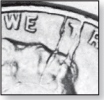
Die cracks
Cracks in the surface of the die allow coin metal to be forced into the crack during the strike, resulting in raised irregular lines of coin metal above the normal surface of the coin. These are one of the commonest forms of die damage and wear, making them easily collectible.
Collar cracks and hub cracks are added to this section because the causes and effects are similar or closely associated.
Die cracks, collar cracks and hub cracks are the result of wear and tear on the tools, with intentional use assumed for all classes.
| II-D-1 Die Crack (W), Rarity Level: 1-3 with a rarity level of 6-7 | Values: 10 to $1, $25 up on a proof coin |
| II-D-2 Multiple Die Cracks (W), Rarity Level: 1-3 | Values: 25 cents to $2 |
| II-D-3 Head-To-Rim Die Crack (Lincoln Cent) (W), Rarity Level: 2-6 | Values: 25 to $10 for multiple die cracks |
| II-D-4 Split Die (W), Rarity Level: 5-6 | Values: $10 up |
| II-D-5 Rim-To-Rim Die Crack (W), Rarity Level: 2-5 | Values: $1 up |
| II-D-6 Collar Crack (W), Rarity Level: 4-6 | Values: $10 up |
| II-D-7 Hub Crack (W), Rarity Level: 3-5 | Values: $1-$2 |

Small die break II-E-2

Clogged letter II-E-1

Major die break, date missing, II-E-5

Rim die break II-E-4
Die breaks (II-E)
Breaks in the surface of the die allow coin metal to squeeze into the resulting holes, causing raised irregular areas above the normal surface of the coin. Die chips and small die breaks are nearly as common as the die cracks, but major die breaks, which extend in from the edge of the coin, are quite rare on the larger coins.
If the broken piece of the die is retained, the resulting design will be above or below the level of the rest of the surface.
| II-E-1 Die Chip (W), Rarity Level: 1-2 | Values: 10 to $1 |
| II-E-2 Small Die Break (W), Rarity Level: 1-3 | Values: 10 to $2 |
| II-E-3 Large Die Break (W), Rarity Level: 3-5 | Values: $1 to $50 and up |
| II-E-4 Rim Die Break (W), Rarity Level: 2-3 | Values: 25 cents to $5 |
| II-E-5 Major Die Break (WE), Rarity Level: 3-6 | Values: $5 to $100 and up |
| II-E-6 Retained Broken Die (W), Rarity Level: 3-5 | Values: $1 to $10 and up |
| II-E-7 Retained Broken Center of the Die (W), Rarity Level: 6-7 | Values: $100 up |
| II-E-8 Laminated Die (W), Rarity Level: 3-5 | Values: 10 cents to $5 |
| II-E-9 Chipped Chrome Plating (W), Rarity Level: 4-5 | Values: $10 to $25 on proofs |
| II-E-10 Collar Break (W), Rarity Level: 4-6 | Values: $5 to $25 and up |
| II-E-11 Broken Letter or Digit on an Edge Die (W), Rarity Level: 4-6 | Values: Minimal. |
| II-E-12 “Bar” Die Break (W), Rarity Level: 3-5 | Values: 25 to $20 |
| II-E-13 Hub Break (W), Rarity Level: 4-6 | Values: 50 to $10 and up |
“BIE” varieties (II-F)
A series of small die breaks or die chips in the letters of “LIBERTY” mostly on the wheat-reverse Lincoln cent are actively collected. The name results from the resemblance to an “I” between the “B” and “E” on many of the dies, but they are found between all of the letters in different cases. Well over 1,500 dies are known and cataloged. Numerous more recent examples are known.
| II-F-1 ILI Die Variety (W), Rarity Level: 4-5 | Values: 25 cents to $10 |
| II-F-2 LII Die Variety (W), Rarity Level: 3-5 | Values: 50 cents to $15 |
| II-F-3 IIB Die Variety (W), Rarity Level: 3-5 | Values: 50 cents to $15 |
| II-F-4 BIE Die Variety (W), Rarity Level: 3-5 | Values: $1 to $20 |
| II-F-5 EIR Die Variety (W), Rarity Level: 3-5 | Values: 50 to $15 |
| II-F-6 RIT Die Variety (W), Rarity Level: 4-5 | Values: $2 to $25 |
| II-F-7 TIY Die Variety (W), Rarity Level: 4-5 | Values: $5 to $30 |
| II-F-8 TYI Die Variety (W), Rarity Level: 4-5 | Values: $2 to $25 |
Worn and damaged dies, collars and hubs (II-G)
Many dies are continued deliberately in service after they have been damaged, dented, clashed or show design transfer, since none of these classes actually affect anything but the appearance of the coin. The root cause is wear, but intent or mistakes may enter the picture.
| II-G-1 Dented Die, Collar or Hub (IWE), Rarity Level: 3-5 | Values: 25 to $5 |
| II-G-2 Damaged Die, Collar or Hub (IWE), Rarity Level: 3-5 | Values: 25 to $5 |
| II-G-3 Worn Die, Collar or Hub (IWE), Rarity Level: 2-3 | Values: No Extra Value to Minimal Value |
| II-G-4 Pitted or Rusted Die, Collar or Hub (IWE), Rarity Level: 3-4 | Values: No Extra Value, marker only |
| II-G-5 Heavy Die Clash (IWE), Rarity Level: 4-5 | Values: $1 to $10 and up |
| II-G-6 Heavy Collar Clash (IWE), Rarity Level: 3-4 | Values: $1 to $5 and up |
| II-G-7 Heavy Design Transfer (IWE), Rarity Level: 3-4 | Values: 10 cents to $1 |
Die progressions (II-H)
The progression section consists of three classes. These are useful as cataloging tools for many different die varieties, but especially the die cracks and die breaks which may enlarge, lengthen or increase in number.
| II-H-1 Progression (W), Rarity Level: 3-5 | Values: $1 up |
| II-H-2 Die Substitution (IW), Rarity Level: 2-4 | Values: No Extra Value to Minimal Value |
| II-H-3 Die Repeat (I), Rarity Level: 2-4 | Values: No Extra Value to Minimal Value |
Die scratches, polished and abraded dies (II-I)
This section consists of those classes having to do with the use of an abrasive in some form to intentionally polish proof dies, or repair the circulating die surface. Several classes that previously were referred to as “polished” now are listed as “abraded.”
| II-I-1 Die Scratch (IW), Rarity Level: 1-2 | Values: No Extra Value to 10 cents to 25 cents, as a marker |
| II-I-2 Polished (proof) Die (IW), Rarity Level: 1 | Values: No Extra Value |
| II-I-3 Abraded (Circulation) Die (IW), Rarity Level: 1-2 | Values: No Extra Value up to $10 |
| II-I-4 Inside Abraded Die Doubling (IW), Rarity Level: 1-3 | Values: No Extra Value to $1 |
| II-I-5 Outside Abraded Die Doubling (IW), Rarity Level: 1-3 | Values: No Extra Value to $1 |
| II-I-6 Lathe Marks (IW), Rarity Level: 5-7 | Values: No Extra Value, marker only |
Striking varieties
Division III
Once the dies are made and the planchets have been prepared, they are struck by a pair of dies and become a coin. In this division, we list the misstrikes resulting from human or mechanical malfunction in the striking process. These are one-of-a-kind varieties, but there may be many similar coins that fall in a given class.
Multiples and combinations of classes must be considered on a case by case basis. The first several sections match the planchet sections indicated in the title.
Struck on defective alloy mix planchets (III-A)
This section includes those classes of coins struck on planchets that were made from a defective alloy.
| III-A-1 Struck on an Improper Alloy Mix Planchet (IE), Rarity Level: 2-3 | Values: 10 cents to $2 |
| III-A-2 Struck on a Planchet With Slag Inclusions(IE), Rarity Level: 5-6 | Values: $10 up |
Struck on damaged, defective or abnormal planchet (III-B)
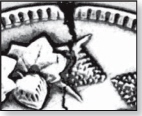
Struck on a defective planchet III-B-1
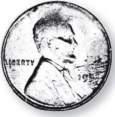
Struck on a tapered planchet III-B-5
Coins get struck on many strange objects. The more common, of course, are planchets that have been damaged in some way in the production process. In most of the classes in this section, intent is at least presumed, if not specifically listed as a cause.
| III-B-1 Struck on a Defective Planchet (IWE), Rarity Level: 4-6 | Values: $5 to $10 and up |
| III-B-2 Struck on a Mechanically Damaged Planchet (IWE), Rarity Level: 5-6 | Values: $10 to $20 and up |
| III-B-3 Struck on a Rolled Thin Planchet (IWE), Rarity Level: 5-6 | Values: $2 to $5 and up |
| III-B-4 Struck on a Rolled Thick Planchet (IWE), Rarity Level: 5-6 | Values: $35 to $50 and up |
| III-B-5 Struck on a Tapered Planchet (WE), Rarity Level: 4-6 | Values: $2 to $5 and up |
| III-B-6 Struck on a Partially Unplated Planchet (WE), Rarity Level: 5 | Values: $10 up |
| III-B-7 Struck on an Unplated Planchet (WE), Rarity Level: 6-7 | Values: $100 up |
| III-B-8 Struck on a Bubbled Plating Planchet (IWE), Rarity Level: 1 | Values: No Value |
| III-B-9 Struck on an Included Gas Bubble Planchet (WE), Rarity Level: 5-6 | Values: $5 up |
| III-B-10 Struck on a Partially Unclad Planchet (WE), Rarity Level: 5-6 | Values: $5 up |
| III-B-11 Struck on an Unclad Planchet (WE), Rarity Level: 4-5 | Values: $5 and up |
| III-B-12 Struck on an Undersize Planchet (WE), Rarity Level: 4-6 | Values: Minimal |
| III-B-13 Struck on an Oversize Planchet (WE), Rarity Level: 6-7 | Values: Minimal |
| III-B-14 Struck on an Improperly Prepared Proof Planchet (IWE), Rarity Level: 3-5 | Values: $5 up |
| III-B-15 Struck on an Improperly Annealed Planchet (IWE), Rarity Level: 4-5 | Values: $5 up |
| III-B-16 Struck on a Faulty Upset Edge Planchet (IWE), Rarity Level: 4-5 | Values: $1 to $2 |
| III-B-17 Struck on a Rolled In Metal Planchet (WE), Rarity Level: 4-6 | Values: $2 up |
| III-B-18 Struck on a Weld Area Planchet (WE), Rarity Level: 6 | Values: $25 to $50 |
| III-B-19 Struck on a Strike Clip Planchet (W), Rarity Level: 6-7 | Values: $25 up |
| III-B-20 Struck on an Unpunched Center Hole Planchet (WE), Rarity Level: 4-6 | Values: $1 and up |
| III-B-21 Struck on an Incompletely Punched Center Hole Planchet (WE), Rarity Level: 6-7 | Values: $5 up |
| III-B-22 Struck on an Uncentered Center Hole Planchet (WE), Rarity Level: 6-7 | Values: $10 up |
| III-B-23 Struck on a Multiple Punched Center Hole Planchet (WE), Rarity Level: 7 | Values: $25 up |
| III-B-24 Struck on an Unintended Center Hole Planchet (WE), Rarity Level: 6-7 | Values: $25 and up |
| III-B-25 Struck on a Wrong Size or Shape Center Hole Planchet (WE), Rarity Level: 5-7 | Values: $5 up |
| III-B-26 Struck on Scrap Coin Metal (E), Rarity Level: 4-6 | Values: $10 up |
| III-B-27 Struck on Junk Non Coin Metal (E), Rarity Level: 4-6 | Values: $15 up |
| III-B-28 Struck on a False Planchet (E), Rarity Level: 3-5 | Values: $35 up |
| III-B-29 Struck on Bonded Planchets (E), Rarity Level: 6-7 | Values: $50 up |
Struck on a clipped planchet (III-C)

Ragged edge clip III-C-15

Multiple clip III-C-8
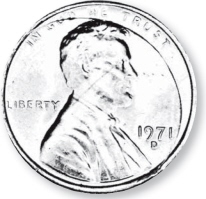
Incomplete curved clip III-C-10
Coins struck on clipped blanks, or planchets, exhibit the same missing areas as they did before striking, modified by the metal flow from the strike which rounds the edges and tends to move metal into the missing areas. Values for blanks will run higher than planchets with similar clips.
| III-C-1 Struck on a Disc Clip Planchet (WE), Rarity Level: 4-5 $20 and up for clad coins | Values: $1 on regular coins, |
| III-C-2 Struck on a Curved Clip Planchet - to 5% (WE), Rarity Level: 3-5 | Values: 50 cents up |
| III-C-3 Struck on a Curved Clip Planchet - (6 to 10%) (WE), Rarity Level: 4-5 | Values: $1 up |
| III-C-4 Struck on a Curved Clip Planchet - (11 to 25%) (WE), Rarity Level: 4-5 | Values: $2 up |
| III-C-5 Struck on a Curved Clip Planchet - (26 to 60%) (WE), Rarity Level: 4-6 | Values: $10 up |
| III-C-6 Struck on a Double Curved Clip Planchet (WE), Rarity Level: 3-4 | Values: $2 up |
| III-C-7 Struck on a Triple Curved Clip Planchet (WE), Rarity Level: 4-5 | Values: $5 up |
| III-C-8 Struck on a Multiple Curved Clip Planchet (WE), Rarity Level: 4-6 | Values: $5 up |
| III-C-9 Struck on an Overlapping Curved Clipped Planchet (WE), Rarity Level: 5-6 | Values: $15 up |
| III-C-10 Struck on an Incomplete Curved Clip Planchet (WE), Rarity Level: 4-5 | Values: $10 up |
| III-C-11 Struck on an Oval Clip Planchet (WE), Rarity Level: 5-6 | Values: $20 up |
| III-C-12 Struck on a Crescent Clip Planchet - (61% or more) (WE), Rarity Level: 6-7 | Values: $100 up |
| III-C-13 Struck on a Straight Clip Planchet (E), Rarity Level: 4-6 | Values: $10 up |
| III-C-14 Struck on an Incomplete Straight Clip Planchet (WE), Rarity Level: 5-6 | Values: $20 up |
| III-C-15 Struck on a Ragged Clip Planchet (E), Rarity Level: 4-6 | Values: $15 up |
| III-C-16 Struck on an Outside Corner Clip Planchet (E), Rarity Level: 7 | Values: $100 up |
| III-C-17 Struck on an Inside Corner Clip Planchet (E), Rarity Level: Unknown outside mint | Values: |
| III-C-18 Struck on an Irregularly Clipped Planchet (E), Rarity Level: 6-7 | Values: $20 up. |
| III-C-19 Struck on an Incompletely Punched Scalloped or Multi-Sided Planchet (E), Rarity Level: 7 | |
| Values: $20 up. |
Struck on a laminated, split or broken planchet (III-D)
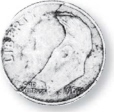
Lamination crack III-D-1
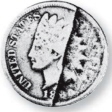
Layer peeled off III-D-2
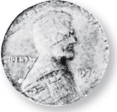
Split planchet III-D-3
This section has to do with the splitting, cracking or breaking of a coin parallel to the faces of the coin, or at least very nearly parallel, or breaks at right angles to the faces of the coin.
Lamination cracks and missing metal of any size below a split planchet are too common in the 35-percent silver 1942-1945 nickels to be collectible or have any significant value.
| cant value. | |
| III-D-1 Struck on a Small Lamination Crack Planchet (W), Rarity Level: 3-4 | Values: 10 up |
| III-D-2 Struck on a Large Lamination Crack Planchet (W), Rarity Level: 3-6 | Values: $1 up |
| III-D-3 Struck on a Split Planchet (W), Rarity Level: 4-6 | Values: $5 up |
| III-D-4 Struck on a Hinged Split Planchet (W), Rarity Level: 5-6 | Values: $35 up |
| III-D-5 Struck on a Planchet With a Clad Layer Missing (W), Rarity Level: 4-5 | Values: $15 up |
| III-D-6 Struck on a Planchet With Both Clad Layers Missing (W), Rarity Level: 4-5 | Values: $25 up |
| III-D-7 Struck on a Separated Clad Layer or Lamination (W), Rarity Level: 6-7 | Values: $75 up |
| III-D-8 Struck on a Broken Planchet Before the Strike (W), Rarity Level: 3-5 | Values: $10 up |
| III-D-9 Broken Coin During or After the Strike (W), Rarity Level: 4-6 | Values: $20 up |
| III-D-10 Struck Coin Fragment Split or Broken During or After the Strike (W), Rarity Level: 3-5 | Values: $5 up |
| III-D-11 Reedless Coin Broken During or After the Strike (W), Rarity Level: Unknown | Values: - |
Struck on wrong stock planchets (III-E)

Quarter on dime stock III-E-7 (lower coin edge)
These classes cover those cases where the wrong stock was run through the blanking press, making planchets of the correct diameter, but of the wrong thickness, alloy or metal or a combination of incorrect thickness and metal.
| III-E-1 Struck on a Half Cent-Stock Planchet (IE), Rarity Level: Unknown | Values: No Value Established |
| III-E-2 Struck on a Cent-Stock Planchet (IE), Rarity Level: Unknown | Values: No Value Established |
| III-E-3 Struck on a Two-Cent-Stock Planchet (E), Rarity Level: Unknown | Values: - |
| III-E-4 Struck on a Three-Cent-Silver Stock Planchet (E), Rarity Level: Unknown | Values: - |
| III-E-5 Struck on a Three-Cent-Nickel Stock Planchet (E), Rarity Level: Unknown | Values: - |
| III-E-6 Struck on a Half Dime-Stock Planchet (E), Rarity Level: Unknown | Values: - |
| III-E-7 Struck on a Dime-Stock Planchet (E), Rarity Level: 5-6 | Values: $20 up |
| III-E-8 Struck on a Twenty-Cent-Stock Planchet (E), Rarity Level: Unknown | Values: - |
| III-E-9 Struck on a Quarter-Stock Planchet (E), Rarity Level: 6 | Values: $50 up |
| III-E-10 Struck on a Half Dollar-Stock Planchet (E), Rarity Level: 6-7 | Values: $100 up |
| III-E-11 Struck on a Dollar-Stock Planchet (E), Rarity Level: 6-7 | Values: $300 up |
| III-E-12 Struck on a Token/Medal-Stock Planchet (E), Rarity Level: 7 | Values: No Value Established |
| III-E-13 Struck on a Wrong Thickness Spoiled Planchet (IWE), Rarity Level: 7 | Values: $50 up |
| III-E-14 Struck on a Correct Thickness Spoiled Planchet (IWE), Rarity Level: Unknown | Values: No Value Established |
| III-E-15 Struck on a Cut Down Struck Token (IWE), Rarity Level: 6-7 | Values: $50 up |
| III-E-16 Struck on an Experimental or Pattern-Stock Planchet (IE), Rarity Level: 7 | Values: $50 up |
| III-E-17 Struck on a Proof-Stock Planchet (IE), Rarity Level: 7 | Values: $100 up |
| III-E-18 Struck on an Adjusted Specification-Stock Planchet (IE), Rarity Level: 3-7 | Values: No Value to $5 and up |
| III-E-19 Struck on a Trial Strike-Stock Planchet (IE), Rarity Level: Unknown | Values: No Value Established |
| III-E-20 U.S. Coin Struck on a Foreign-Stock Planchet. (E), Rarity Level: 5 | Values: $35 up |
| III-E-21 Foreign Coin Struck on a Foreign-Stock Planchet (E), Rarity Level: 5-6 | Values: $25 up |
| III-E-22 Struck on a Non-Standard Coin Alloy (IE), Rarity Level: 4-7 | Values: $20 up |
Extra metal (III-F)

Extra metal on a
struck coin (III-F-2)

Sintered coating III-F-3
The term “extra metal” for the purpose of this section includes both extra metal added to the blank during the blanking operation and metal powder added to the planchet during the annealing operation.
| III-F-1 Struck on a Type 1 Blank With Extra Metal (W), Rarity Level: Unknown | Values: - |
| III-F-2 Struck on a Type 2 Planchet With Extra Metal (W), Rarity Level: 4-5 | Values: $10 up |
| III-F-3 Struck on a Sintered Coating Planchet (W), Rarity Level: 6-7 | Values: $35 up |
Struck on normal or abnormal blanks, or planchets (III-G)

Half on dime
planchet III-G-10
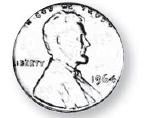
Cent on dime
planchet III-G-10
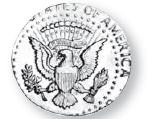
Half on quarter
planchet III-G-10
This section includes coins struck on either a blank, as it comes from the blanking press, or as a planchet that has passed through the upsetting mill. Added to this section are those planchets that are normal until they are struck by the wrong dies. These differ from the wrong stock planchets because the wrong stock planchets are already a variety before they are struck.
| III-G-1 Struck on a Type 1 Blank (IWE), Rarity Level: 4-6 | Values: $10 up |
| III-G-2 Struck on a Type 2 Planchet (I), Rarity Level: 1 | Values: No Extra Value |
| III-G-3 Struck on a Purchased Planchet (I), Rarity Level: 1 | Values: No Extra Value |
| III-G-4 Struck on a Mint-Made Planchet (I), Rarity Level: 1 | Values: No Extra Value |
| III-G-5 Struck on an Adjustment-Marked Planchet (I), Rarity Level: 4-7 | Values: Minimal, and may |
| reduce value of coin in some cases | |
| III-G-6 Struck on a Hardness Test-Marked Planchet (I), Rarity Level: 6-7 | Values: $10 up |
| III-G-7 Wrong Planchet or Metal on a Half Cent Planchet (IE), Rarity Level: 5-7 | Values: $100 up |
| III-G-8 Wrong Planchet or Metal on a Cent Planchet (IE), Rarity Level: 3-6 | Values: $25 up |
| III-G-9 Wrong Planchet or Metal on a Nickel Planchet (E), Rarity Level: 4-6 | Values: $35 up |
| III-G-10 Wrong Planchet or Metal on a Dime Planchet (E), Rarity Level: 4-6 | Values: $50 up |
| III-G-11 Wrong Planchet or Metal on a Quarter Planchet (E), Rarity Level: 4-6 | Values: $100 up |
| III-G-12 Wrong Planchet or Metal on a Half Dollar Planchet (E), Rarity Level: 6-7 | Values: $500 up |
| III-G-13 Wrong Planchet or Metal on a Dollar Planchet (E), Rarity Level: 7 | Values: $500 up |
| III-G-14 Wrong Planchet or Metal on a Gold Planchet (E), Rarity Level: 7 | Values: $1000 up |
| III-G-15 Struck on a Wrong Series Planchet (IE), Rarity Level: 6-7 | Values: $1500 up |
| III-G-16 U.S. Coin Struck on a Foreign Planchet (E), Rarity Level: 5-7 | Values: $35 up |
| III-G-17 Foreign Coin Struck on a U.S. Planchet (E), Rarity Level: 6-7 | Values: $50 up |
| III-G-18 Foreign Coin Struck on a Wrong Foreign Planchet (E), Rarity Level: 6-7 | Values: $50 up |
| III-G-19 Struck on a Medal Planchet (E), Rarity Level: 6-7 | Values: $100 up |
| III-G-20 Medal Struck on a Coin Planchet (IE), Rarity Level: 3-5 | Values: $10 up |
| III-G-21 Struck on an Official Sample Planchet (IE), Rarity Level: Unknown | Values: No Value Established |
| III-G-22 Struck Intentionally on a Wrong Planchet (I), Rarity Level: 6-7 Pieces, full numismatic value | Values: Mainly struck as Presentation |
| III-G-23 Non-Proof Struck on a Proof Planchet (IE), Rarity Level: 6-7 | Values: $500 up |
Struck on coin metal strip (III-H)
Pieces of the coin metal strip do manage at times to escape into the coin press.
| III-H-1 (See I-H-1 Punched Coin Metal Strip), Rarity Level: Impossible | Values: - |
| III-H-2 Struck on Chopped Coin Metal Strip (E), Rarity Level: 6-7 | Values: $25 up |
Die adjustment strikes (III-I)
As the dies are set up and adjusted in the coin press, variations in the strike occur until the dies are properly set. Test strikes are normally scrapped, but on occasion reach circulation.
| III-I-1 Die Adjustment Strike (IE), Rarity Level: 5-6 | Values: $35 up |
| III-I-2 Edge Strike (E), Rarity Level: 5-6 | Values: $10 to $20 and up |
| III-I-3 Weak Strike (W), Rarity Level: 1 | Values: No Extra Value |
| III-I-4 Strong Strike (IWE), Rarity Level: 1 that might be paid for a well struck coin | Values: No value except for the premium |
| III-I-5 Jam Strike (IE), Rarity Level: 7 | Values: $50 up |
| III-I-6 Trial Piece Strike (I), Rarity Level: 6-7 | Values: $100 up |
| III-I-7 Edge-Die Adjustment Strike (I), Rarity Level: 5-7 | Values: $5 up |
| III-I-8 Uniface Strike (I), Rarity Level 7 | Values: $50 up |
Indented, brockage and counter-brockage strikes (III-J)

Indented strike
III-J-1

Counter-brockage strike
III-J-11

Capped die strike
III-J-15
Indented and uniface strikes involve an extra unstruck planchet between one of the dies and the planchet being struck. Brockage strikes involve a struck coin between one of the dies and the planchet and a counter-brockage requires a brockage coin between one of the dies and the planchet.
A cap, or capped die strike results when a coin sticks to the die and is squeezed around it in the shape of a bottle cap.
| III-J-1 Indented Strike (W), Rarity Level: 3-6 | Values: $5 up |
| III-J-2 Uniface Strike (W), Rarity Level: 3-5 | Values: $15 up |
| III-J-3 Indented Strike By a Smaller Planchet (WE), Rarity Level: 5-7 | Values: $100 up |
| III-J-4 Indented Second Strike (W), Rarity Level: 3-5 double strike of comparable size | Values: $10 up, about the same as a regular |
| III-J-5 Partial Brockage Strike (W), Rarity Level: 3-6 | Values: $15 up |
| III-J-6 Full Brockage Strike (W), Rarity Level: 3-6 | Values: $5 up |
| III-J-7 Brockage Strike of a Smaller Coin (WE), Rarity Level: 6-7 | Values: $200 up |
| III-J-8 Brockage Strike of a Struck Coin Fragment (WE), Rarity Level: 4-6 | Values: $5 up |
| III-J-9 Brockage Second Strike (WE), Rarity Level: 3-5 | Values: $5 up |
| III-J-10 Partial Counter-Brockage Strike (WE), Rarity Level: 3-5 | Values: $10 up |
| III-J-11 Full Counter-Brockage Strike (WE), Rarity Level: 5-7 | Values: $100 up |
| III-J-12 Counter-Brockage Second Strike (WE), Rarity Level: 4-6 | Values: $10 up |
| III-J-13 Full Brockage-Counter-Brockage Strike (WE), Rarity Level: 6-7 | Values: $150 up |
| III-J-14 Multiple Brockage or Counter-Brockage Strike (WE), Rarity Level: 5-7 | Values: $100 up |
| III-J-15 Capped Die Strike (WE), Rarity Level: 6-7 | Values: $500 up |
| III-J-16 Reversed Capped Die Strike (WE), Rarity Level: 7 | Values: $1,000 up |
Struck through abnormal objects (III-K)

Struck through cloth
III-K-1

Struck through a filled die
III-K-4
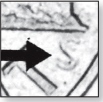
Struck through a
dropped filling III-K-5
This section covers most of the objects or materials that might come between the planchet and the die and be struck into the surface of the coin. Unless noted, the materials - even the soft ones - are driven into the surface of the coin.
| III-K-1 Struck Through Cloth (IWE), Rarity Level: 3-6 | Values: $35 up |
| III-K-2 Struck Through Wire (IWE), Rarity Level: 3-6 | Values: $5 up |
| III-K-3 Struck Through Thread (IWE), Rarity Level: 3-6 | Values: $5 up |
| III-K-4 Struck Through Dirt-and-Grease-Filled Die (IWE), Rarity Level: 1-4 | |
| Values: 10 cents to 25 cents up, but no value on a worn or circulated coin | |
| III-K-5 Struck Through a Dropped Filling (IWE), Rarity Level: 5-6 | Values: $10 up |
| III-K-6 Struck Through Wrong Metal Fragments (IWE), Rarity Level: 4-6 | Values: $1 up |
| III-K-7 Struck Through an Unstruck Planchet Fragment (IWE), Rarity Level: 3-5 | Values: $1 up |
| III-K-8 Struck Through a Rim Burr (IWE), Rarity Level: 3-5 | Values: $1 to $2 and up |
| III-K-9 Struck Through plit-Off Reeding (IWE), Rarity Level: 5-6 | Values: $25 up |
| III-K-10 Struck Through a Feed Finger (IWE), Rarity Level: 5-7 | Values: $25 to $50 and up |
| III-K-11 Struck Through Miscellaneous Objects (IWE), Rarity Level: 4-6 | Values: $1 up |
| III-K-12 Struck Through Progression (IWE), Rarity Level: 4-6 | Values: $1 up |
Note: Some 1987 through 1994 quarters are found without mintmarks, classed as III-K-4, a Filled Die. Values depend on market conditions. Filled dies have value ONLY on current, uncirculated grade coins.
Double strikes (III-L)
Only coins that receive two or more strikes by the die pair fall in this section and are identified by the fact that both sides of the coin are affected. Unless some object interferes, an equal area of both sides of the coin will be equally doubled.
The exception is the second strike with a loose die, which will double only one side of a coin, but is a rare form usually occurring only on proofs. A similar effect is flat field doubling from die chatter.
| III-L-1 Close Centered Double Strike (WE), Rarity Level: 4-6 | Values: $15 up |
| III-L-2 Rotated Second Strike Over a Centered First Strike (WE), Rarity Level: 4-6 | Values: $15 up |
| III-L-3 Off-Center Second Strike Over a Centered First Strike (WE), Rarity Level: 4-6 | Values: $15 up |

Off-center second strike over
centered first strike III-L-3

Non-overlapping
double strike III-L-8

Multiple strike III-L-16
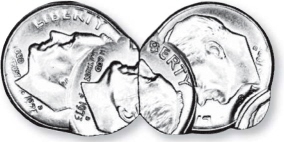
Chain strike III-L-10
| III-L-4 Off-Center Second Strike Over an Off-Center First Strike (WE), Rarity Level: 4-6 | Values: $10 up |
| III-L-5 Off-Center Second Strike Over a Broadstrike (WE), Rarity Level: 5-6 | Values: $20 up |
| III-L-6 Centered Second Strike Over an Off-Center First Strike (WE), Rarity Level: 5-6. | Values: $50 up |
| III-L-7 Obverse Struck Over Reverse (WE), Rarity Level: 5-6 | Values: $25 up |
| III-L-8 Nonoverlapping Double Strike (WE), Rarity Level: 5-6 | Values: $20 up |
| III-L-9 Struck Over a Different Denomination or Series (WE), Rarity Level: 6 | Values: $300 and up |
| III-L-10 Chain Strike (WE), Rarity Level: 6 | Values: $300 up for the pair of coins that were struck together |
| III-L-11 Second-Strike Doubling From a Loose Die (W), Rarity Level: 6-7 | Values: $200 up |
| III-L-12 Second-Strike Doubling From a Loose Screw Press Die (W), Rarity Level: 5-6 | Values: $100 up |
| III-L-13 Second Strike on an Edge Strike (WE), Rarity Level: 5-6 | Values: $20 up |
| III-L-14 Folded Planchet Strike (WE), Rarity Level: 5-7 | Values: $100 up |
| III-L-15 Triple Strike (WE), Rarity Level: 6-7 | Values: $100 up |
| III-L-16 Multiple Strike (WE), Rarity Level: 6-7 | Values: $200 up |
| III-L-17 U.S. Coin Struck Over a Struck Foreign Coin (WE), Rarity Level: 6-7 | Values: $300 up |
| III-L-18 Foreign Coin Struck Over a Struck U.S. Coin (WE), Rarity Level: 6-7 | Values: $400 up |
| III-L-19 Foreign Coin Struck Over a Struck Foreign Coin (WE), Rarity Level: 7 | Values: $500 up |
| III-L-20 Double Strike on Scrap or Junk (E), Rarity Level: 6 | Values: $50 up |
| III-L-21 Struck on a Struck Token or Medal (E), Rarity Level: 5-6 | Values: $100 up |
| III-L-22 Double-Struck Edge Motto or Design (E), Rarity Level: 6-7 | Values: $200 up |
| III-L-23 One Edge Motto or Design Struck Over Another (E), Rarity Level: 7 | Values: $300 up |
| III-L-24 Flat Field Doubling (W), Rarity Level: 2-3 | Values: $1 to $5 |
| III-L-25 Territorial Struck over Struck U.S. Coin: (I) Rarity Level: 6-7 | Values: $200 up |
| III-L-26 Pattern Struck over Struck U.S. Coin: (I) Rarity Level: 6-7 | Values: $200 up |
| III-L-27 Pattern Struck over Struck Pattern:(I) Rarity Level 6-7 | Values: $200 up |
| III-L-28 Pattern Struck Over Foreign Coin:(I) Rarity Level 6-7 | Values - $200 up |
Collar striking varieties (III-M)
The collar is often referred to as the “Third Die,” and is involved in a number of forms of misstrikes. The collar normally rises around the planchet, preventing it from squeezing sideways between the dies and at the same time forming the reeding on reeded coins.
If the collar is out of position or tilted, a partial collar strike results; if completely missing, it causes a broadstrike; if the planchet is not entirely between the dies, an off-center strike.

Flanged partial collar III-M-1

Struck off center
10 to 30 percent III-M-7

Struck off center
31 to 70 percent III-M-8

Struck off center
71 percent or more III-M-9
| III-M-1 Flanged Partial Collar Strike (WE), Rarity Level: 5-6 | Values: $20 up |
| III-M-2 Reversed Flanged Partial Collar Strike (WE), Rarity Level: 6-7 | Values: $35 up |
| III-M-3 Tilted Partial Collar Strike (WE), Rarity Level: 5-6 | Values: $20 up |
| III-M-4 Centered Broadstrike (WE), Rarity Level: 5-6 | Values: $5 up |
| III-M-5 Uncentered Broadstrike (WE), Rarity Level: 5 | Values: $3 up |
| III-M-6 Reversed Broadstrike (WE), Rarity Level: 6 | Values: $10 up |
| III-M-7 Struck Off-Center 10-30% (W), Rarity Level: 3-6 | Values: $3 up |
| III-M-8 Struck Off-Center 31-70% (W), Rarity Level: 4-6 | Values: $5 up |
| III-M-9 Struck Off-Center 71% or More (W), Rarity Level: 3-5 | Values: $2 up |
| III-M-10 Rotated Multi-sided Planchet Strike (W), Rarity Level: 5-6 | Values: $10 up |
| III-M-11 Wire Edge Strike (IWE), Rarity Level: 1-2 | Values: No Extra Value |
| III-M-12 Struck With the Collar Too High (WE), Rarity Level: 6-7 | Values: $20 up |
| III-M-13 Off-Center Slide Strike (W), Rarity Level: 3-6 | Values: $4 up |
Misaligned and rotated (die) strike varieties (III-N)

Misaligned die III-N-1

Normal rotation

90 degrees

180 degrees
One (rarely both) of the dies may be Offset Misaligned, off to one side, or may be tilted (Vertically Misaligned). One die may either have been installed so that it is turned in relation to the other die, or may turn in the holder, or the shank may break allowing the die face to rotate in relation to the opposing die.
Vertical misaligned dies are rarely found, and, like rotated dies, find only limited collector interest. Ninety- and 180-degree rotations are the most popular. Rotations of 14 degrees or less have no value. The 1989-D Congress dollar is found with a nearly 180-degree rotated reverse, currently retailing for around $2,000. Only about 30 have been reported to date.
| III-N-1 Offset Die Misalignment Strike (WE), Rarity Level: 3-5 | Values: $2 up |
| III-N-2 Vertical Die Misalignment Strike (WE), Rarity Level: 4-6 | Values: $1 up |
| III-N-3 Rotated Die Strike - 15 to 45 Degrees (IWE), Rarity Level: 4-6 | Values: $2 up |
| III-N-4 Rotated Die Strike - 46 to 135 Degrees (IWE), Rarity Level: 5-6 | Values: $10 up |
| III-N-5 Rotated Die Strike - 136 to 180 Degrees (IWE), Rarity Level: 5-6 | Values: $25 up |
Lettered and design edge strike varieties (III-O)
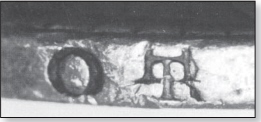
Overlapping edge letters III-O-1
Early U.S. coins and a number of foreign coins have either lettered edges or designs on the edge of the coin. Malfunctions of the application of the motto or design to the edge fall in this section.
| III-O-1 Overlapping Edge Motto or Design (WE), Rarity Level: 3-4 | Values: $5 to $10 and up |
| III-O-2 Wrong Edge Motto or Design (WE), Rarity Level: 5-6-7 | Values: $50 up |
| III-O-3 Missing Edge Motto, Design or Security Edge (IWE), Rarity Level: 5-6-7 | Values: $50 up |
| III-O-4 Jammed Edge Die Strike (W), Rarity Level: 6 | Values: $10 up |
| III-O-5 Misplaced Segment of an Edge Die (E), Rarity Level: 4-7 | Values: $25 up |
| III-O-6 Reeded Edge Struck Over a Lettered Edge (IE), Rarity Level: 3-6 | Values: No Extra Value up |
Defective strikes and mismatched dies (III-P)
The final section of the Striking Division covers coins that are not properly struck for reasons other than those in previous classes, such as coins struck with mismatched (muled) dies. The mismatched die varieties must be taken on a case by case basis, while the other classes presently have little collector demand or premium.
| III-P-1 Defective Strike (WE), Rarity Level: 1 | Values: No Extra Value |
| III-P-2 Mismatched Die Strike (E), Rarity Level: 4-7 | Values: $25 up |
| III-P-3 Single-Strike Proof (WE), Rarity Level: 4-5 | Values: Minimal |
| III-P-4 Single Die-Proof Strike (IE), Rarity Level: 5-6 | Values: $100 up |
| III-P-5 Reversed Die Strike (I), Rarity Level: 4-5 | Values: No Extra Value to Minimal |
Official Mint modifications
Division IV
Several mint-produced varieties occur after the coin has been struck, resulting in the addition of the fourth division to my PDS System. Since most of these coins are either unique or are special varieties, each one must be taken on a case by case basis. All classes listed here are by definition intentional.
I have not listed values as the coins falling in these classes, which are sold through regular numismatic channels, are cataloged with the regular issues or are covered in specialized catalogs in their particular area.
Matte proofs (IV-A)
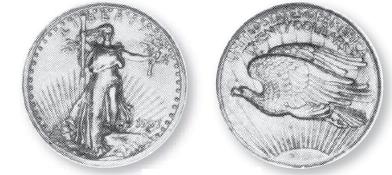
Matte proofs IV-A-1
Matte proofs as a section include several of the forms of proof coins that have the striking characteristics of a mirror proof but have been treated AFTER striking to give them a grainy, non-reflective surface.
| them a grainy, non-reflective surface. | |
| IV-A-1 Matte Proof (I), Rarity Level: 3-5 | Values: Normal Numismatic Value |
| IV-A-2 Matte Proof on One Side (I), Rarity Level: 7 | Values: Normal Numismatic Value |
| IV-A-3 Sandblast Proof (I), Rarity Level: 4-6 | Values: Normal Numismatic Value |
Additional engraving (IV-B)
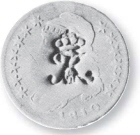
Counterstamp IV-B-3
This section includes any added markings that are placed on the struck coin and struck coins that later were cut into pieces for various purposes. The warning is repeated: Anything done to a coin after the strike is extremely difficult t o authenticate and is much easier to fake than a die struck coin.
| IV-B-1 Counterstamp and Countermark (I), Rarity Level: 3-6 | Values: Normal Numismatic Value |
| IV-B-2 Perforated and Cut Coins (I), Rarity Level: 4-6 | Values: Normal Numismatic Value |
Restrikes (IV-C)
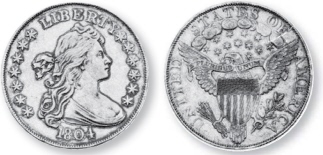
Restrike with new dies IV-C-7
Restrikes cover a complicated mixture of official use of dies from a variety of sources. Whether or not some were officially sanctioned is always a problem for the collector.
| IV-C-1) Restrike on the Same Denomination Planchet (I), Rarity Level: 4-6. . .Values: Normal Numismatic Value | |
| IV-C-2 Restrike on a Different Denomination or Series Planchet (I), Rarity Level: 4-6 | |
| Values: Normal Numismatic Value | |
| IV-C-3 Restrike on a Foreign Coin (I), Rarity Level: 6-7 | Values: Normal Numismatic Value |
| IV-C-4 Restrike on a Token or Medal (I), Rarity Level: 5-6 | Values: Normal Numismatic Value |
| IV-C-5 Restruck With the Original Dies (I), Rarity Level: 4-6 | Values: Normal Numismatic Value |
| IV-C-6 Restruck With Mismatched Dies (I), Rarity Level: 4-6 | Values: Normal Numismatic Value |
| IV-C-7 Copy Strike With New Dies (I), Rarity Level: 3-5 | Values: Normal Numismatic Value |
| IV-C-8 Fantasy Strike (I), Rarity Level: 4-6 | Values: Normal Numismatic Value |
After strike modifications
Division V
This division includes both modifications that have value to collectors – and those that don’t. I needed a couple of divisions to cover other things that happen to coins to aid in cataloging them. This avoids the false conclusion that an unlisted coin is quite rare, when the exact opposite is more likely to be the case.
Collectible modifications after strike (V-A)
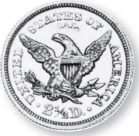
Mint modification V-A-8
This section includes those classes having to do with deliberate modifications of the coin done with a specific purpose or intent that makes them of some value to collectors. Quite often these pieces were made specifically to sell to collectors, or at least to the public, under the guise of being collectible.
| V-A-1 Screw Thaler, Rarity Level: 5-6 | Values: Normal Numismatic Value |
| V-A-2 Love Token, Rarity Level: 3-6 | Values: $10 up |
| V-A-3 Satirical or Primitive Engraving, Rarity Level: 6-7 | Values: $5 up |
| V-A-4 Elongated Coin, Rarity Level: 2-7 | Values: 50 cents to $1 and up |
| V-A-5 Coin Jewelry, Rarity Level: 2-5 | Values: $1 up |
| V-A-6 Novelty Coin, Rarity Level: 1-3 | Values: No Value up to $5 to $10 |
| V-A-7 Toning, Rarity Level: 3-6 | Values: No value up, depending on coloration. Easily faked |
| V-A-8 Mint Modification, Rarity Level: 4-7 | Values: $5 up. Easily faked |
| V-A-9 Mint Packaging Mistake, Rarity Level: 5-7 | Values: Nominal $1. Very easily faked |
Alterations and damage after the strike (V-B)
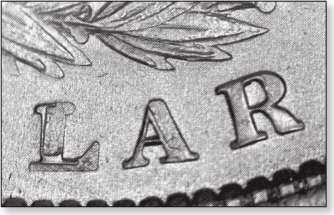
Machine doubling damage V-B-1
This section includes those changes in a coin that have no collector value. In most cases, their effect on the coin is to reduce or entirely eliminate any collector value - and in the case of counterfeits they are actually illegal to even own.
V -B-1 Machine Doubling Damage: NOTE: Machine doubling damage is defined as: “Damage to a coin after the strike, due to die bounce or chatter or die displacement, showing on the struck coin as scrapes on the sides of the design elements, with portions of the coin metal in the relief elements either displaced sideways or downward, depending on the direction of movement of the loose die.” Machine doubling damage, or MDD, is by far the most common form of doubling found on almost any coin in the world.
| Rarity Level: 0 | Values: Reduces the coin’s value |
| V-B-2 Accidental or Deliberate Damage, Rarity Level: 0 | Values: Reduces the coin’s value |
| V-B-3 Test Cut or Mark, Rarity Level: 0 | Values: Reduces value of coin to face or bullion value |
| V-B-4 Alteration, Rarity Level: 0 | Values: Reduces value to face or bullion value |
| V-B-5 Whizzing, Rarity Level: 0 | Values: Reduces value sharply and may reduce it to face or bullion value |
| V-B-6 Counterfeit, Copy, Facsimile, Forgery or Fake, Rarity Level: 0 | Values: No Value and may be illegal to own |
| V-B-7 Planchet Deterioration. Very common on copper-plated zinc cents. Rarity level: 0 | Values: No Value |